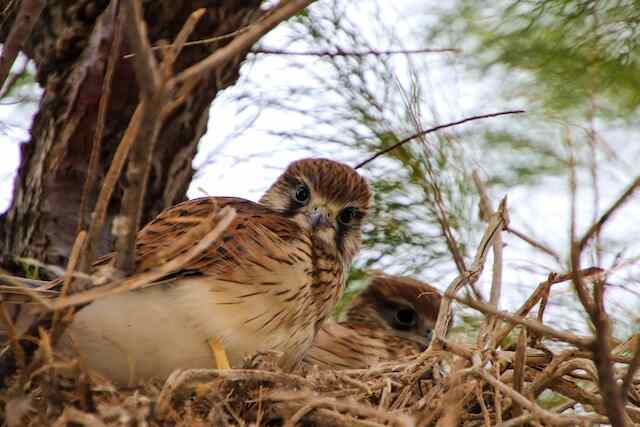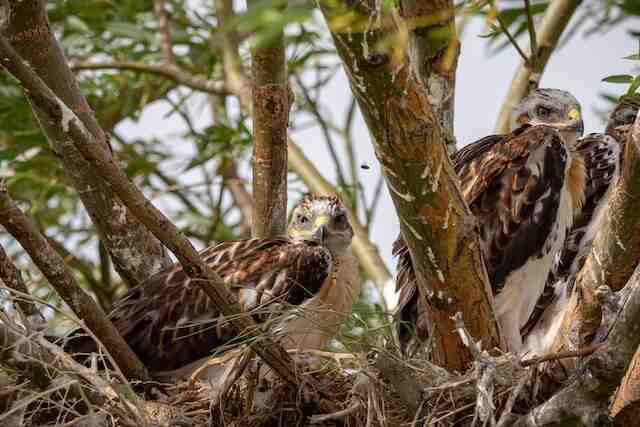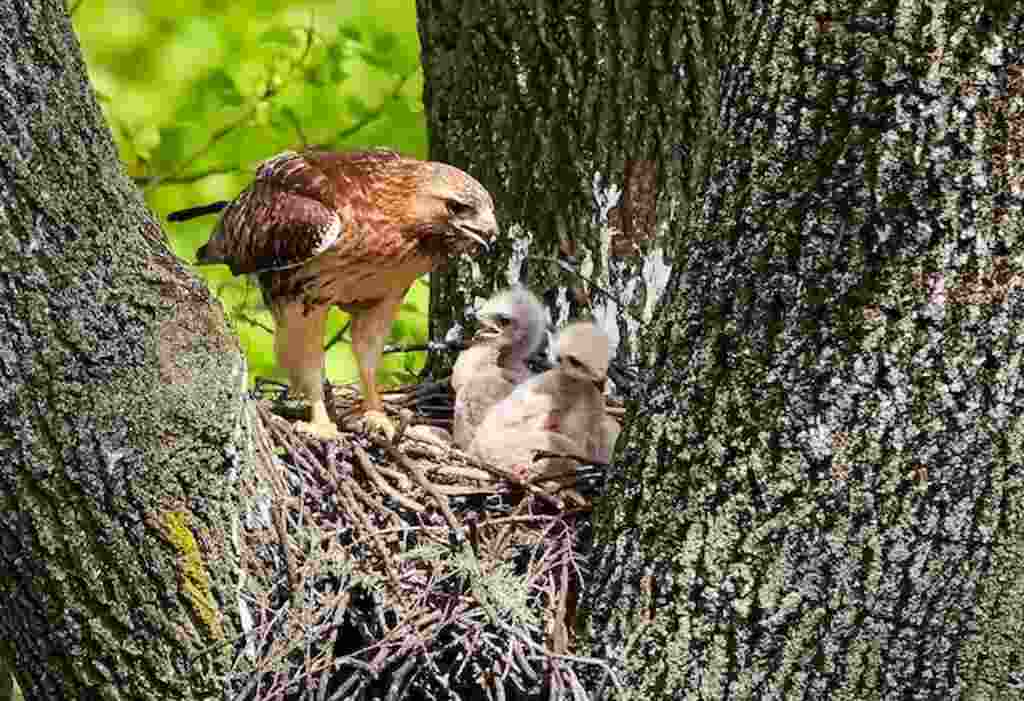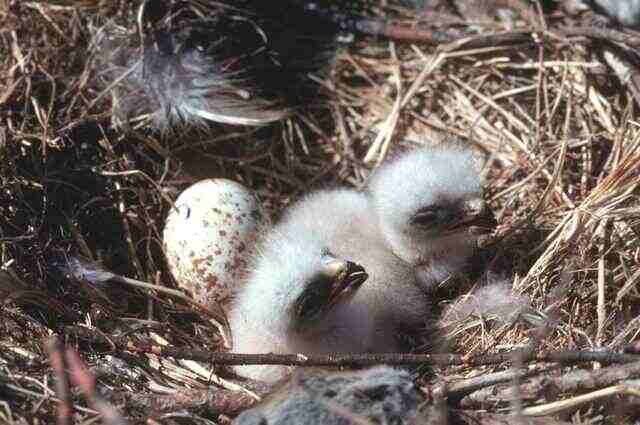Prepare for a soaring expedition into the hidden realm of hawk love! Hawks, majestic birds of prey with sharp talons and keen eyesight, captivate us worldwide.
But amidst their fierce hunting prowess, their romantic lives remain shrouded in mystery. Do hawks breed for life?
Let’s uncover their secrets of monogamy, explore the factors influencing their mating habits, and appreciate the vital role these connections play in our ecosystems.
Get ready to witness the captivating dance of hawk courtship as we unravel the enigmatic world of these magnificent feathered romantics!
Table of Contents
- 1 Key Takeaways
- 2 Do Hawks Breed For Life?
- 3 Introduction to Hawks and Their Mating Habits
- 4 The Concept of Monogamy in Hawks
- 5 Factors that Influence Hawk Mating Habits
- 6 The Importance of Hawk Mating Habits
- 7 Monogamy in Red-Tailed Hawks
- 8 Polygamy in Cooper’s Hawks
- 9 Other Hawk Species and Their Mating Habits
- 10 Challenges to Hawk Mating Habits
- 11 Conclusion
- 12 Frequently Asked Questions
- 12.1 What is the average lifespan of a hawk?
- 12.2 How do hawks choose their mating partners?
- 12.3 What is the success rate of hawk mating pairs in terms of producing offspring?
- 12.4 Do hawks exhibit any unique courtship behaviors during mating season?
- 12.5 How do environmental factors such as climate change affect hawk mating habits?
- 13 Author
Key Takeaways
- Monogamous behavior is observed in many hawk species, resulting in better cooperation and parental care.
- Environmental conditions and population density influence hawk mating habits and breeding success.
- Red-tailed hawks are monogamous, while Cooper’s hawks are polygamous.
- Understanding hawk mating habits is crucial for effective conservation strategies and protecting hawk habitats.
Do Hawks Breed For Life?
Yes, some hawk species exhibit lifelong monogamy. While not all hawks breed for life, notable examples include the Red-tailed Hawk and Harris’s Hawk.
Monogamous pairs engage in courtship rituals, build nests together, and share parental duties. However, breeding habits can vary among hawk species, with some practicing serial monogamy or polygyny.
Introduction to Hawks and Their Mating Habits
The mating habits of hawks are a topic of interest within the field of ornithology, particularly with regard to whether they mate for life.
Hawk courtship involves rituals such as aerial displays, vocalizations, and the exchange of food.
Once a pair forms, they engage in breeding behavior, including nest building and egg laying.
While many species of birds are known to mate for life, the concept of monogamy in hawks is still debated among experts.
Some researchers suggest that hawks may form long-term pair bonds, while others argue that they may engage in extra-pair copulations.
Ultimately, the mating habits of hawks demonstrate the complexity of avian relationships and the importance of further research in this field.
The Concept of Monogamy in Hawks
Monogamous behavior in hawks, observed in many species, raises the question of whether this is a common strategy among birds of prey.
Hawks are known to mate for life, with the pair remaining together throughout the breeding season and often returning to the same nesting site year after year.
This monogamous behavior is thought to be an evolutionary adaptation to ensure genetic diversity in offspring.
Hawks that mate for life are able to form strong bonds, which may result in better cooperation during the breeding season and increased parental care for the offspring.
However, not all hawks exhibit monogamous behavior, and some species are known to engage in extra-pair copulations.
This suggests that factors such as environmental conditions and population density may influence hawk mating habits.
Understanding the factors that influence hawk mating habits can provide insight into the genetic diversity of bird populations and the evolution of avian behavior.

Factors that Influence Hawk Mating Habits
Factors such as environmental conditions and population density play a role in influencing the mating habits of certain hawk species, including the likelihood of engaging in extra-pair copulations.
In areas where food is abundant and territories are large, hawks tend to engage in monogamous relationships, while in areas where resources are scarce and population density is high, hawks are more likely to participate in extra-pair copulations.
Additionally, breeding success is influenced by factors such as age, experience, and genetic fitness. These factors can impact the hawk’s ability to attract a mate and successfully produce offspring.
Understanding the influence factors on hawk mating habits is crucial in developing effective conservation strategies for these remarkable birds.
The importance of hawk mating habits extends beyond breeding success, as it can also impact the health of ecosystems and the biodiversity of our planet.
The Importance of Hawk Mating Habits
Understanding the role of mating habits in hawk populations is essential for effective conservation efforts, as these birds play a crucial role in maintaining ecosystem health and biodiversity, serving as apex predators and indicators of environmental health.
Hawks are known for their remarkable ability to adapt to changing environmental conditions, but their mating habits are equally important for maintaining ecological balance.
The importance of hawk mating habits lies in their ecological impact, as they influence population dynamics, genetic diversity, and evolutionary processes.
For instance, in monogamous species like the red-tailed hawk, pair-bonding ensures long-term reproductive success and the transfer of beneficial traits to offspring.
Additionally, understanding the role of hawk mating habits can help conservationists develop effective strategies for managing populations and preserving habitats.
By studying mating behaviors, researchers can track changes in population size, reproductive success, and genetic diversity, which are critical indicators of ecosystem health.
In the next section, we will explore the fascinating world of monogamy in red-tailed hawks and how it contributes to their survival.

Monogamy in Red-Tailed Hawks
The mating system of red-tailed hawks plays a crucial role in their survival and reproductive success. These birds are monogamous, meaning that they form long-term pair bonds with one mate.
This breeding behavior ensures that the parents work together to raise their young and protect their territory from other hawks and predators.
Red-tailed hawks also exhibit a complex social structure, with individuals forming hierarchies based on their age and breeding status.
By breeding for life, these birds are able to establish a stable social structure that allows them to successfully raise their offspring.
However, not all hawks exhibit monogamous behavior. In the next section, we will explore the breeding habits of cooper’s hawks, which are known for their polygamous behavior.
Polygamy in Cooper’s Hawks
While monogamy is the norm for Red-Tailed Hawks, other hawk species exhibit different breeding patterns. One such species is the Cooper’s Hawk, which is known for its polygamous nature.
This means that a male Cooper’s Hawk may mate with several females during the breeding season. This behavior is thought to increase genetic diversity within the species.
To understand the polygamous behavior of Cooper’s Hawks better, researchers have conducted extensive studies on their breeding habits.
Here are some fascinating insights into the breeding patterns of Cooper’s Hawks:
- Cooper’s Hawks are known to mate with several females, but they also engage in intense competition for mates.
- The male Cooper’s Hawk is responsible for building the nest and providing food for the female during the breeding season.
- Females may mate with more than one male, and they are known to select mates based on their hunting ability and the quality of their nest-building skills.
- Polygamy in Cooper’s Hawks may have evolved as a strategy to increase genetic diversity and ensure the survival of the species.
Understanding the breeding patterns of different hawk species is essential for conservation efforts and species management. In the next section, we will explore the mating habits of other hawk species and the factors that influence their behavior.

Other Hawk Species and Their Mating Habits
Despite the seemingly monogamous nature of Red-Tailed Hawks, other hawk species exhibit a more complex and diverse range of breeding patterns.
Some species, such as the Northern Goshawk, exhibit strict monogamy and mate for life, while others, like the Sharp-Shinned Hawk, practice polygamy.
Additionally, some hawk species exhibit territoriality during breeding season, with males competing for the right to mate with a female in their territory.
For example, the Ferruginous Hawk will defend its breeding territory and the female from other males.
Overall, the breeding behavior of hawks varies greatly among species and is influenced by factors such as territoriality and mating patterns.
Understanding these behaviors can provide insight into the challenges that hawks face in their mating habits, which will be explored in the subsequent section.
Challenges to Hawk Mating Habits
Challenges to hawk mating habits pose significant obstacles for successful reproduction, highlighting the importance of understanding the factors that influence these behaviors.
The impact of climate change on hawk breeding is one such factor that has been shown to negatively affect mating and reproductive success.
As temperatures rise and weather patterns become more unpredictable, breeding seasons may shift, leading to a mismatch between the availability of prey and the timing of offspring hatching.
Furthermore, habitat destruction is another major challenge for hawk mating.
As natural habitats are destroyed or altered, hawks may struggle to find suitable nesting sites, which can lead to a decline in the number of successful breeding pairs.
The loss of suitable nesting sites can also increase competition among hawks, leading to more aggressive behaviors and decreased reproductive success.
Understanding the impact of climate change and habitat destruction on hawk mating habits is essential for conservation efforts aimed at preserving these magnificent birds of prey.
In the conclusion and future research directions, we will explore potential solutions to these challenges and highlight areas for further study.

Conclusion
In conclusion, the mating habits of hawks have been a subject of much research and study. The concept of monogamy in hawks has been well documented, with red-tailed hawks being among the most monogamous of all hawk species.
On the other hand, polygamy has been observed in certain hawk species, such as the Cooper’s hawk.
Various factors have been found to influence hawk mating habits, including food availability, habitat quality, and social dynamics.
The importance of hawk mating habits lies in their contribution to the survival and success of the species.
However, challenges such as habitat loss and climate change may impact hawk mating habits and require further research.
In future studies, it would be interesting to explore the genetic basis of hawk mating habits and how they may have evolved over time.
Additionally, investigating the impact of human activities on hawk mating habits could provide insight into the conservation of these majestic creatures.
Ultimately, understanding the intricacies of hawk mating habits is crucial for their survival and the preservation of biodiversity.
Frequently Asked Questions
What is the average lifespan of a hawk?
The average lifespan of a hawk varies depending on the species, with some living up to 25 years. Hawk breeding habits are diverse, with some species mating for life and others engaging in multiple breeding partners.
How do hawks choose their mating partners?
Hawks mate for life to ensure genetic diversity and maximize fitness. Mate selection criteria involve physical displays, vocalizations, and courtship feeding. Hawk pairs may also engage in aerial displays to strengthen their bond and territorial defense.
What is the success rate of hawk mating pairs in terms of producing offspring?
The success rate of hawk mating pairs in terms of producing offspring is influenced by factors such as mating frequency and breeding season variations. Studies have shown that hawks may have multiple partners, but the success of each pair varies.
Do hawks exhibit any unique courtship behaviors during mating season?
During mating season, hawks exhibit elaborate rituals, including aerial displays and territorial behavior. These behaviors serve to attract a mate and establish dominance. Such intricate courtship displays showcase the freedom and beauty of these magnificent birds.
How do environmental factors such as climate change affect hawk mating habits?
Environmental factors such as habitat destruction and pollution have a significant impact on hawk mating patterns. However, hawks have shown adaptability to changing environmental conditions during mating season, indicating their ability to cope with the challenges of the changing world.



